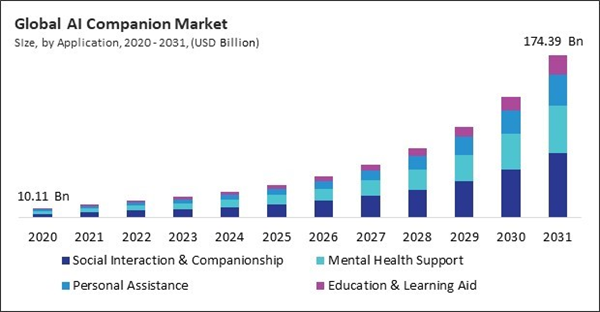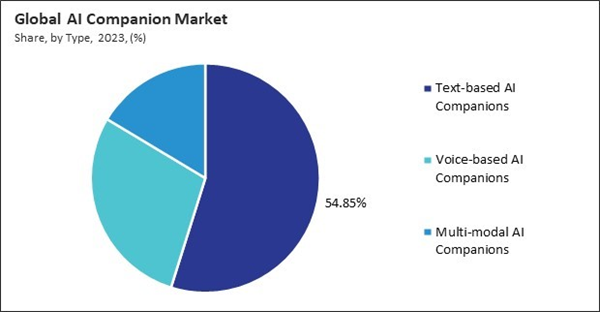The Global AI Companion Market size is expected to reach $174.39 billion by 2031, rising at a market growth of 29.8% CAGR during the forecast period.
The North America segment recorded 34% revenue share in the market in 2023. This dominance is driven by the high adoption of advanced AI technologies and the presence of key regional market players. Increasing demand for these companions in mental health support, personal assistance, and smart home integration have fueled market growth.
The growing consumer demand for personalized experiences is a key driver of the market. Consumers increasingly expect services that adapt to their needs and preferences, and these companions are designed to meet this demand. In retail, healthcare, and education industries, these companions can provide tailored solutions such as personalized shopping experiences, health monitoring, and learning paths for students. Thus, as consumers demand more personalized services, businesses heavily invest in these companion technologies to meet these expectations, driving market growth.
Additionally, Over the past few years, the public’s attitude toward artificial intelligence and automation has noticed a noticeable shift. Initially met with skepticism, AI technologies are now widely integrated into everyday life, from voice assistants like Siri and Alexa to recommendation algorithms on streaming platforms such as Netflix. As more consumers experience the convenience and efficiency AI provides, they become more comfortable with these companions performing various tasks, from managing daily schedules to offering companionship. Hence, as AI benefits become clearer, public acceptance will drive growing demand for these companions across sectors, further expanding the market.
However, Developing these companions requires significant financial investment in research, technology, and infrastructure. These companion systems are complex, requiring the integration of machine learning algorithms, natural language processing (NLP), and data analytics to function effectively. These technologies require vast computational power, high-quality data for training models, and ongoing refinement to improve the system’s accuracy and adaptability. As a result, companies may face difficulties in scaling their AI companion offerings, limiting the reach and impact of this technology in the early stages of market growth.
The leading players in the market are competing with diverse innovative offerings to remain competitive in the market. The above illustration shows the percentage of revenue shared by some of the leading companies in the market. The leading players of the market are adopting various strategies in order to cater demand coming from the different industries. The key developmental strategies in the market are Acquisitions, and Partnerships & Collaborations.
The North America segment recorded 34% revenue share in the market in 2023. This dominance is driven by the high adoption of advanced AI technologies and the presence of key regional market players. Increasing demand for these companions in mental health support, personal assistance, and smart home integration have fueled market growth.
The growing consumer demand for personalized experiences is a key driver of the market. Consumers increasingly expect services that adapt to their needs and preferences, and these companions are designed to meet this demand. In retail, healthcare, and education industries, these companions can provide tailored solutions such as personalized shopping experiences, health monitoring, and learning paths for students. Thus, as consumers demand more personalized services, businesses heavily invest in these companion technologies to meet these expectations, driving market growth.
Additionally, Over the past few years, the public’s attitude toward artificial intelligence and automation has noticed a noticeable shift. Initially met with skepticism, AI technologies are now widely integrated into everyday life, from voice assistants like Siri and Alexa to recommendation algorithms on streaming platforms such as Netflix. As more consumers experience the convenience and efficiency AI provides, they become more comfortable with these companions performing various tasks, from managing daily schedules to offering companionship. Hence, as AI benefits become clearer, public acceptance will drive growing demand for these companions across sectors, further expanding the market.
However, Developing these companions requires significant financial investment in research, technology, and infrastructure. These companion systems are complex, requiring the integration of machine learning algorithms, natural language processing (NLP), and data analytics to function effectively. These technologies require vast computational power, high-quality data for training models, and ongoing refinement to improve the system’s accuracy and adaptability. As a result, companies may face difficulties in scaling their AI companion offerings, limiting the reach and impact of this technology in the early stages of market growth.
The leading players in the market are competing with diverse innovative offerings to remain competitive in the market. The above illustration shows the percentage of revenue shared by some of the leading companies in the market. The leading players of the market are adopting various strategies in order to cater demand coming from the different industries. The key developmental strategies in the market are Acquisitions, and Partnerships & Collaborations.
Driving and Restraining Factors
Drivers
- Rising Demand For Personalized User Experiences And Tailored Support
- Growing Public Acceptance Of AI And Automation In Daily Life
- Increasing Application Of AI Companions In Education For Personalized Learning
Restraints
- High Development Costs And Resource Requirements For Creating Advanced AI Companions
- Concerns Over Privacy And Data Security Due To Continuous Collection Of Personal Information
Opportunities
- Rising Investments In AI Research And Development
- Improvement In AI-Enabled Chatbots For Customer Service And Engagement
Challenges
- Limited Emotional Intelligence And The Inability To Fully Replicate Human-Like Empathy
- Legal And Regulatory Issues Surrounding The Use Of AI Companions
Application Outlook
Based on application, the market is characterized into social interaction & companionship, mental health support, personal assistance, and education & learning aid. The mental health support segment procured 29% revenue share in the market in 2023. These companions are increasingly used as tools for emotional well-being, offering stress management, mood tracking, and mental health monitoring. They provide immediate assistance and can complement therapy by offering round-the-clock support.Type Outlook
On the basis of type, the market is classified into text-based AI companions, voice-based AI companions, and multimodal AI companions. The voice-based AI companions segment recorded 29% revenue share in the market in 2023. The growing popularity of smart speakers and virtual assistants has driven the demand for voice-based AI companions. These companions offer hands-free interaction, making them highly convenient for reminders, real-time responses, and emotional engagement.Industry Vertical Outlook
By Industry Vertical, the market is divided into consumers, businesses, healthcare, education, and others. The businesses segment garnered 23% revenue share in the market in 2023. Organizations increasingly leverage these companions for customer engagement, virtual assistance, and personalized support services. These companions help improve customer satisfaction by providing instant responses and scalable support. Additionally, industries such as retail and finance are adopting these companions to enhance user interaction and reduce operational costs.Regional Outlook
Region-wise, the market is analyzed across North America, Europe, Asia Pacific, and LAMEA. The Europe segment witnessed 32% revenue share in the market in 2023. Growing awareness of digital well-being solutions and increasing focus on emotional support applications have driven demand for these companions in this region. Countries like the UK, Germany, and France are at the forefront of adopting AI-driven solutions across various sectors, including healthcare and education.List of Key Companies Profiled
- Amazon Web Services, Inc. (Amazon.com, Inc.)
- IBM Corporation
- Google LLC (Alphabet Inc.)
- Microsoft Corporation
- OpenAI, LLC
- Zoom Video Communications, Inc.
- DataRobot, Inc.
- Oracle Corporation
- NVIDIA Corporation
- KNIME AG
Market Report Segmentation
By Application
- Social Interaction & Companionship
- Mental Health Support
- Personal Assistance
- Education & Learning Aid
By Type
- Text-based AI Companions
- Voice-based AI Companions
- Multi-modal AI Companions
By Industry Vertical
- Consumer
- Businesses
- Healthcare
- Education
- Other Industry Vertical
By Geography
- North America
- US
- Canada
- Mexico
- Rest of North America
- Europe
- Germany
- UK
- France
- Russia
- Spain
- Italy
- Rest of Europe
- Asia Pacific
- China
- Japan
- India
- South Korea
- Singapore
- Malaysia
- Rest of Asia Pacific
- LAMEA
- Brazil
- Argentina
- UAE
- Saudi Arabia
- South Africa
- Nigeria
- Rest of LAMEA
Table of Contents
Chapter 1. Market Scope & Methodology
Chapter 2. Market at a Glance
Chapter 3. Market Overview
Chapter 4. Competition Analysis - Global
Chapter 5. Global AI Companion Market by Application
Chapter 6. Global AI Companion Market by Type
Chapter 7. Global AI Companion Market by Industry Vertical
Chapter 8. Global AI Companion Market by Region
Chapter 9. Company Profiles
Companies Mentioned
- Amazon Web Services, Inc. (Amazon.com, Inc.)
- IBM Corporation
- Google LLC (Alphabet Inc.)
- Microsoft Corporation
- OpenAI, LLC
- Zoom Video Communications, Inc.
- DataRobot, Inc.
- Oracle Corporation
- NVIDIA Corporation
- KNIME AG
Methodology

LOADING...









